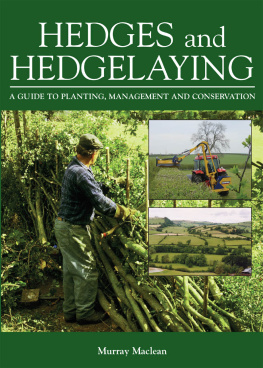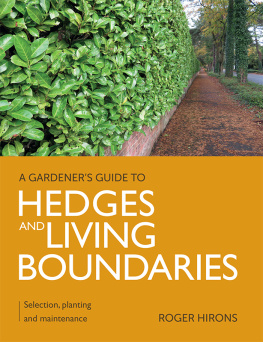
HEDGES and
HEDGELAYING
A GUIDE TO PLANTING, MANAGEMENT AND CONSERVATION
Murray Maclean

THE CROWOOD PRESS
First published in 2006 by
The Crowood Press Ltd
Ramsbury, Marlborough
Wiltshire SN8 2HR
www.crowood.com
This e-book first published in 2015
Murray Maclean 2006
All rights reserved. No part of this publication may be reproduced or transmitted in any form or by any means, electronic or mechanical, including photocopy, recording, or any information storage and retrieval system, without permission in writing from the publishers.
British Library Cataloguing-in-Publication Data
A catalogue record for this book is available from the British Library.
ISBN 978 1 78500 055 3
Disclaimer
Chainsaws and all other tools and equipment used in the management of hedges should be used in strict accordance with both the current health and safety regulations and the manufacturers instructions. The author and publisher do not accept any responsibility in any manner whatsoever for any error or mission, or any loss, damage, injury, adverse outcome, or liability of any kind incurred as a result of the use of any of the information contained in this book, or reliance upon it.
Contents
From Anglo-Saxon woodland clearances to the prosperity of the Middle Ages; the enclosure movement; the impact of the railways; the Industrial Revolution and agricultural depression; the Great War; World War II and airfield building; post-war farm mechanization and prosperity; the twenty-first century
Species suitable for a country hedgerow; and species to be avoided; regional differences in the choice of species; plant provenance
Soil surveys; the local landscape
Birds; mammals; invertebrates; wild flowers
Planning; choice and supply of planting material; ground preparations; planting time and conditions; hedge position; marking out; care of plants prior to planting; single or double-row spacings; hand planting; machine planting; care after planting
The Devonwade hedge-bank; the Pembroke hedge-bank; a hedge with two faces; willow hedges; holly hedges; the holm oak (evergreen oak) hedge
Suitable fruiting and timber trees for use in hedges; common trees not recommended for hedgerow planting; spacing
A habitat for wildlife; creating an arable field margin; natural sward regeneration; sown sward mixes; the timing of mowings; exclusion of fertilizers and pesticides
Organic mulches; polythene and woven matting; the considered use of herbicides
Hygiene and the limited use of pesticides
Brushing up; coppicing; mechanical trimming; individual plant protection; fencing
Early references leading on to todays revival of the craft
Equipment and tools; safety procedures; how to cut and lay a hedge; The National Hedge-Laying Society
Different county styles
Acknowledgements
However much knowledge I have gained regarding hedges during my working life, I still continue to learn more. The discovery of new ideas and information continues to shape my understanding of our rich heritage of hedges and their role in the countryside.
In writing this new book on hedges and hedge laying, I have been helped by others who have specific knowledge or skills that have been invaluable to me, enabling me to present a more balanced and fuller coverage of the subject. My sincerest thanks go to the following:
Nigel Adams | Hedge layer |
Janet Allen (ADAS) | Weed and disease control |
Caroline Benson | Museum of English Rural Life, Reading: photographs |
Carolyn Blackmore | Computer assistance |
John Davison | Hollies |
Chris Honeywell | Photographer |
Gordon Maclean | Photographs (my father died in 1999) |
Clive Leeke | Hedge layer and instructor |
Valerie Petts | Line drawings |
John Savings | Hedge layer and my instructor |
Chris Tucker | Bomford Turner Ltd, hedge trimmers |
I reserve my deepest gratitude for those who have given me the most consistent help throughout the preparation of this book, and without whose help this undertaking would have been much more difficult. My wife Joey has read carefully through all that has been written, and made corrections and suggestions that have been most welcome.
I have been involved with the growing and planting of hedges for many years, but I did not have the same deep understanding of the art of hedge laying; for practical training in this skill I have been extremely fortunate to have been able to turn to John Savings. John has taught me the basic skills, and has answered every question with the patience and good humour for which he is renowned. He is a skilled, professional hedge layer who has won many competitions and was honoured to instruct His Royal Highness The Prince of Wales (currently the patron of the National Hedge-laying Society).
Introduction
In recent years hedges have enjoyed a much greater level of public awareness and interest in their wellbeing, which has resulted in a greater appreciation of their beauty and benefit to us all.
In the years following the end of World War II our long heritage of hedgerows suffered in the drive to increase agricultural output to feed a nation that had lost many of its rural roots. Prior to the war, a burgeoning urban population had been increasingly fed by food imports from around the world. Shortages of food during the war galvanized the Ministry of Agriculture to increase home food production. This food from our own resources programme continued until well into the late 1980s before enough questions were asked about the high cost of support for farmers and the increasingly detrimental effects this was having on the fabric of the countryside.
Farmers had responded to the wartime need for increased food production by embracing mechanization wholeheartedly. The horse as the main source of power on the land was almost completely replaced by the tractor within fifteen years following the end of the war. With the advent of the tractor came a vast array of new machinery that the tractor could pull and operate. Both became ever larger and more sophisticated, requiring bigger fields within which to work effectively.
So began the widespread removal of hedges across most arable counties of England. The Ministry of Agriculture encouraged this hedge removal with the payment of generous grants to clear and drain land to increase food production and improve efficiency. This drive for greater output enabled food to be produced at a lower cost. Food prices fell steadily in the decades following the war, to the inevitable point where farmers found themselves having to make even further cost savings in order to retain a modest profit from the production of their crops.
As we move into the twenty-first century farmers now face new demands from their masters in government. With cheap food imports once more supplying an increasing proportion of the nations food requirement, the pressure to feed the people has been replaced by a need to restore and conserve the landscape for the enjoyment and recreation of an almost totally urban population.
The farmers role has changed from being that of respected food producers to the custodians of our rural heritage. Grants for food production have been replaced with mountains of directives and forms extolling the virtues of every conceivable aspect of conservation. Hedges, ponds, woodlands, heath and moorland are all now the chosen beneficiaries of grant aid and other inducements to both conserve and extend them.
Next page













